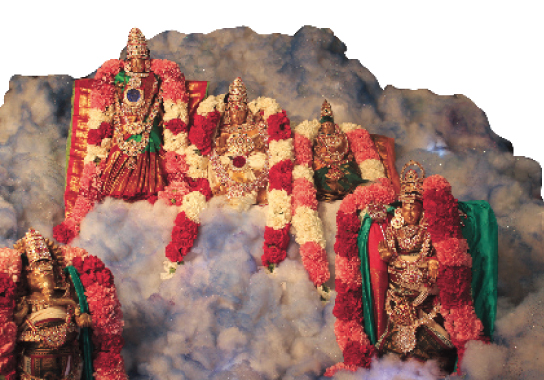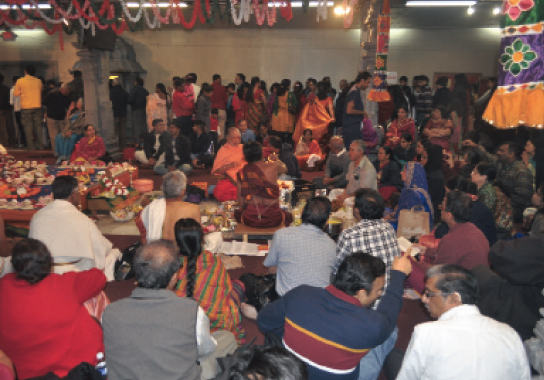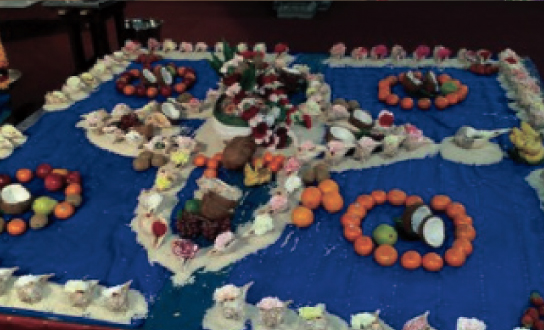Memorable Mahasivarathri at Sri Meenakshi Temple
PEARLAND: By the time the sun set on February 27, the parking lot at Sri Meenakshi Temple was full. Fervent devotees had the strong will to do the pradakshinam (circumbulation) around the temple despite the nippy weather, for they had the faith that an opportunity to be in the vicinity of a Siva sannidhi on Mahasivarathri at dusk is a blessing. There was an unusually large crowd this year for the worship due to the astrological significance to this year’s Mahasivarathri coinciding with Shravana nakshatram – the most venerated day for the worship of Sri Venkateswara.
Sivaratri is observed on the 13th night/14th day in the Krishna Paksha on the fortnight of waning moon every year on the month of Phalguni (Masi, or kumbham). As the twilight turned darker, most of the devotees were seated around the beautifully decorated pedestal at the center of the main temple. As the priests Sri Manicka Bhattar and Sri Kalyanasundaram initiated the sankalpam, the devotees were to witness a time honored ritual of high esteem. The major sequence of steps including Sankha pooja, Rudra homam, and Sivabhishekam, elevated the spiritual strength in every devotee. Simultaneously, at the Venkateswara sannidhi, an elaborate Shravana pooja that accompanied abhishekam and a traditional aradhana was conducted. The entire hall reverberated with the sound of mahamantrams.
Among the ways to adore and admire the majesty of Lord Siva, abhishekam of Sivalinga with the water poured from the Shankha (Shankha-abhishekam) is considered very auspicious. The priests ceremoniously carried the 108 shankha filled with the sanctified water to Sundareswara sannidhi to perform the abhishekam. The temple resounded with the esteemed divine words arranged in the most auspicious Sri Rudram, during the course of the abhishekam. The 108 gold bilva archana was one of the special highlights. The immaculate chanting of Veda by the priests supported by the ritwiks elevated the impact of the rituals to an exalted level. All the devotees assembled had the opportunity to perform the most auspicious abhishekam of Siva lingam in a specially arranged set up.
Arrangement had been made at Natarajar Sannidhi for the sangeetha-nritha upasakas to offer their devotion through their artistic talent. It also added to the vibrant atmosphere of the evening. Following a prayer song by the MTS Vedic Heritage School, students from several local schools (such as Silambam, Anjali) danced before the Lord of dance, Nataraja. Music and Bhajans continued to echo through the evening, and was coordinated by MTS board’s Mala Gopal. Many Siva devotees continued to be present at Sri Sundareswara sannidhi to attend Chathur- kala pooja by singing bhajans. As a tradition, abhishekam and archana were repeated every 90 minutes during the night. It has been the practice that Sivarathri is the only time the temple remains open to the public in the late night. This year, nearly one hundred devotees stayed awake throughout the night. Some believe that Sivarathri symbolizes the wedding day of Lord Siva and Parvathi, while others believe it is the night when Lord Siva performed the Tandava Nritya (the dance of primordial creation/preservation/ destruction).
The MTS Religious activities committee (led by Narayanan, Sriram, Sasi Pillai), and the volunteers deserve appreciation for their tireless work to ensure a memorable experience for over 700 devotees who attended the great night of Lord Siva at Sri Meenakshi temple.



